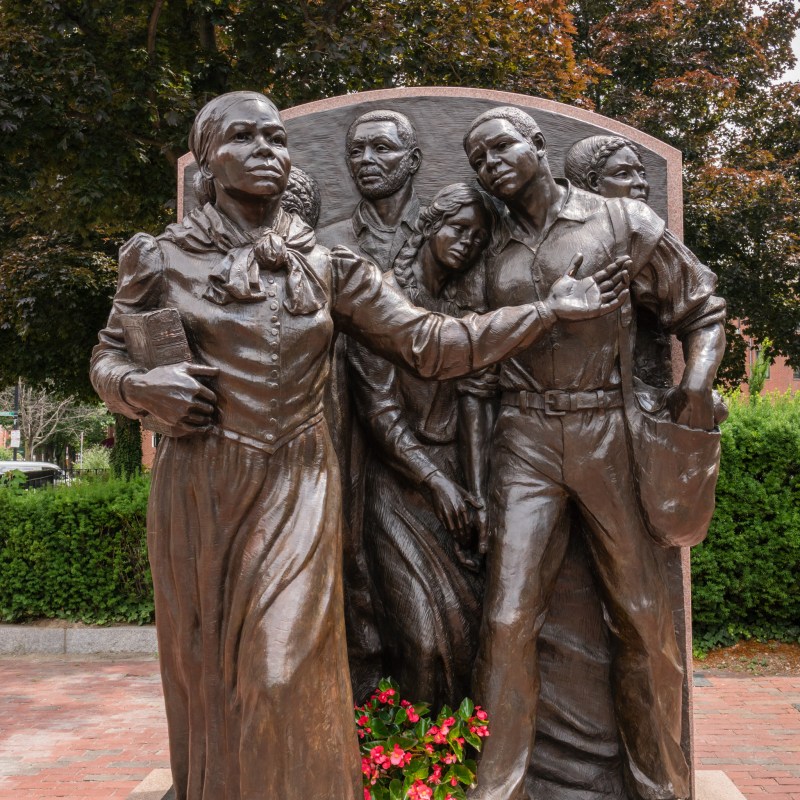
The Boston Women’s Heritage Trail is a collection of walks around the Boston area. I recently spent a sunny afternoon walking around Boston exploring several of the Boston Women’s Heritage Trails stops. The walks and stops bring many women-focused historical events to life.
Videos by TravelAwaits
The story of the origins of the Boston Women’s Heritage Trail began in 1989. Young students and their teachers were on a school field trip. They were curious why all the statues around Boston were just of men. The teachers, librarians, and community members began the process of imagining and creating the Boston Women’s Heritage Trail.
Katherine Dibble, a board of directors Trustee for the Boston Women’s Heritage Trail, is a stalwart supporter of educating the public about the role of women in Boston’s history and their contributions to the Commonwealth of Massachusetts. Dibble, a retired librarian, worked at the Boston Public Library for 37 years.
As I planned my own Women’s Heritage Trail experience, Dibble told me, “We are so proud of the Women’s Heritage Trail and the focus on women’s roles in Boston History. Go out for a walk and enjoy Boston and our trails. You will find a lot of interesting information.”
1. Road To The Vote: The Boston Women’s Suffrage Trail
The Road to the Vote: The Boston Women’s Suffrage Trail, the Women’s Heritage Trail’s newest walk, was conceived to celebrate the 100th anniversary of the 19th Amendment — women’s right to vote. The amendment was adopted on August 18, 1920. Boston’s suffragette history played an important role in the adoption of this constitutional amendment, and this walk highlights those women’s contributions.
Although there are several stops that have historically significant statues, the Road to the Vote Trail is almost three miles if you don’t get turned around. Much of the trail is a building walk-by devoid of markings. According to Dibble, “It is more of an informational trail, where all the historical significance is highlighted on the website.”
The trail officially begins at the Massachusetts State House on the second floor. Here, six bust reliefs line the hall, five depicting women active in Boston’s suffrage movement: Florence Luscomb, Mary Kenney O’Sullivan, Sarah Parker Remond, Josephine St. Pierre RufElsfin, and Lucy Stone. The sixth woman featured is Dorothea Dix, an activist for the mentally ill.
If you choose to walk the Road to the Vote: The Boston Women’s Suffrage Trail, you will traverse many Boston neighborhoods from the State House to Commonwealth Avenue getting a true sense of the city.
The final stop on the Road to the Vote: The Boston Women’s Suffrage Trail is the Boston Women’s Memorial. Designed and sculpted by Meredith Bergmann, the Boston Women’s Memorial on Commonwealth Avenue depicts three important women in Boston’s history: Lucy Stone, Abigail Adams, and Phillis Wheatley. It is a must-visit for anyone interested in Boston’s history and the perfect end to this walk, or a great place to go after the Massachusetts State House if you opt not to complete the full walk.
Next up, lunch. Stephanie’s on Newbury is a good option and only one block up from the Boston Women’s Memorial.

2. Downtown Walk
The Downtown Walk begins at the State House. This area surrounds the Boston Common, an inviting park perfect for a leisurely stroll.
At the State House’s West Wing stands a statue of Anne Hutchinson (1591-1643). Hutchinson was a respected midwife but was banished from Boston in 1638 for heresy. Her crime: She preached that men and women’s souls were equal.
A Mary Dyer (1611-1660) statue graces the East Wing of the State House. Dyer was a Quaker and preached for religious freedom. She was hanged in Boston Common for her beliefs.
One other stop of note is the Granary Burying Ground behind the Park Street Church. Here, the grave of Abiah Franklin, Benjamin Franklin’s mother, is marked with a tall granite obelisk. Also buried here is Elizabeth Foster Vergoose, also known as Mother Goose.
3. North End Walk
Boston’s North End is classically Italian. Home to families that can trace their heritage generations back to Italy, the area is replete with amazing Italian cuisine.
Behind every great man is a great woman. Such a great woman was Rachel Walker Revere, the second wife of Paul Revere. Not only did she raise his six children from his first wife, but she also bore another eight children. During this walk, you can visit the beautifully restored Paul Revere House, where you will step back in time to American Revolutionary days.
If you are in the mood for a cannoli, stop at Mike’s Pastry and grab a dozen to go; one just won’t be enough.

4. Beacon Hill Walk
Beacon Hill, a picturesque Boston neighborhood known for its stately old brownstones, is just steps from the Massachusetts State House and adjacent to the Boston Common. A walk through this fashionable area treats visitors to a historic vibe felt in few places around the city.
The Beacon Hill walk also begins at the State House where many of the important historical figures are immortalized. The walk winds you through the streets of Beacon Hill as you explore the facades of the houses that anti-slavery proponents and suffragettes called home.
The Portia School Of Law, a women-only law school established in 1908, is now the New England School of Law. It is of particular interest since in 1923 Blanche Woodson Braxton, a graduate, was the first African American woman to be admitted to the Massachusetts Bar. The school is now located at 154 Stuart Street, moved from its original location at 45-47 Mount Vernon Street in Beacon Hill.
Another notable Beacon Hill figure is Dr. Rebecca Lee Crumpler, the first African American woman to receive a medical degree. An 1864 graduate of the New England Female Medical College, Crumpler published her Book of Medical Discourses, a memoir of her life experiences. You will pass by her home on the Beacon Hill Walk.
5. Chinatown/South Cove Walk
The walk through Chinatown begins at the Boston Common Visitor Center. As you stroll through Chinatown and the theater district, you can imagine a neighborhood teeming with working artists and garment factory workers mingled with the intoxicating aroma of classic Chinese cooking.
The Boston Opera House, now the Citizens Bank Opera House, was the performance home to the 20th-century opera conductor and impresario Sarah Caldwell. Known for her daring and innovative operatic productions, Caldwell drew many important opera singers and opera lovers to Boston.
Chinatown is a wonderful place to stop for lunch. Whether you crave dumplings, dim sum, noodles, or sushi, you will find plenty of classic Chinese cuisine options on this walkabout.

6. Back Bay East Walk
Expansive gardens and wide, tree-lined walkways define Back Bay. This walk takes you through the Public Garden known for its manicured lawns and floral gardens. As you visit the Public Gardens and discover the wonderful sculptures and statues highlighted on the walk, take time to relax on a park bench, ride on the swan boats, or simply soak up the glorious oasis in the middle of the city. A must-see is the famous Make Way for Ducklings, the work of local sculptor Nancy Schon. Other garden sculptures by women include Triton Babies by Anna Coleman Ladd, Bagheera by Lilian Swann Saarinen, Small Child by Mary Moore, and Boy and Bird by Bashka Paeff.
From the garden, continue down Commonwealth Avenue, which is designed to resemble a Parisian Boulevard with a wide greenway cutting down the middle of the brownstone mansion line street. Simmons College, Emerson College, Fisher College, The French Cultural Center, The Massachusetts Audubon Society, and The Windsor School for Girls were or still are located along this section of the Back Bay. As you pass by the locations of these institutions, you are reminded of Boston’s commitment to education, including the education of young women as early as the mid-1800s.
Running parallel to Commonwealth Avenue is Newbury Street, a shopper’s paradise. Lined with boutiques and high-end retailers, you can spend the day lost in window shopping. This bustling Boston neighborhood has plenty of restaurants and cafes where you can rest your feet and enjoy a tasty meal along with the history.
7. Back Bay West Walk
The Back Bay West walk begins at Copley Square, home to Copley Place, Boston’s upscale shopping mall.
The first stop on this walk is the famous Boston Public Library (BPL), which opened its doors in 1854. When you step inside this magnificent building, you realize books must always be with us, no matter how much our technology advances. Be sure to walk up the Grand Staircase from the lobby to the second floor. This is the perfect time to pass on the elevator.
Many library professionals at the BPL were involved in creating a culture of change for women. Louise Imogen Guiney worked at the BPL and wrote over 30 books; a challenge for anyone in the early 1900s. Alice M. Jordan founded the New England Round Table of Children’s Literature — the first local group dedicated to children’s librarians — in 1906. In the 1940s, Beryl Robinson began a program of children’s storytime, beginning a culture of gathering together and sharing books and experiences.
As you traverse the streets of the Back Bay stops on this walk, keep an eye to the buildings. You will find interesting architectural details on the older building that sit comfortably next to the new modern structures.
Like the Boston Women’s Suffrage Trail, this walk also ends at the Boston Women’s Memorial on Commonwealth Avenue, one of the city’s important tributes to women’s contributions to Boston’s history.

8. South End Walk
This walk begins at Back Bay Station in Boston’s South End. This hip and funky neighborhood is home to trendy eateries and pubs. Renovated old warehouses are homes to galleries, studios, and boutiques. The South End is a neighborhood built for exploring.
Be sure to visit Harriet Tubman Square, where the Emancipation and Step on Board statues proudly stand. The statues crafted by African American women, Meta Vaux Warrick Fuller and Fern Cunningham depict the freedom movement led by bold and determined people.
Pro Tips
Choose one or more of these historic walks and explore some of Boston’s famous neighborhoods. Take your time as you stroll down cobbled streets, enjoy a break at a local cafe, and experience Boston’s vibrant historical importance for women and for our country.
Tour information: Tours are provided for groups of 10 or more with a donation of $10 per person to the Women’s Heritage Trail. You can also take a guided tour with Boston By Foot, which offers guided tours that follow some of the Women’s Heritage Trail walks.
If you prefer to journey from your sofa, each walk is detailed on the Boston Women’s Heritage Trail website, which includes history, photographs, and information about the lives of the courageous women honored at various stops.
If you are spending time in the Boston area, read up on 10 can’t-miss historical sites in and around Boston and 11 things everyone should do in Boston, too.
